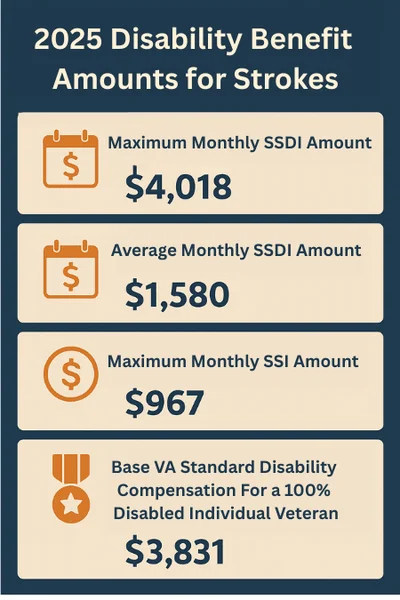Learn how you could qualify for disability benefits if you have difficulty communicating or moving your limbs following a stroke.
A stroke is a serious medical emergency that happens when blood flow to the brain is reduced or stopped entirely (typically due to a blocked blood vessel or cranial hemorrhage), resulting in brain damage. Strokes can have lasting effects such as difficulty speaking, trouble maintaining balance, or vision problems.
While some people are able to fully recover from the effects of a stroke, others are left with ongoing physical and mental limitations that can interfere with their ability to be employed at the level of what the Social Security Administration (SSA) calls substantial gainful activity. If it's been at least one year since your stroke and you're still unable to work, you can qualify for benefits provided you have the appropriate medical evidence to be considered disabled.
- How Can I Get Disability for a Stroke?
- VA Disability Benefit Ratings for Stroke Victims
- Medical Records That Help Prove Disability Following a Stroke
- How Much Can Stroke Victims Get in Government Assistance?
- How to Apply for SSDI, SSI, or VA Disability After a Stroke
- How Hard Is It to Get Disability Benefits for a Stroke?
How Can I Get Disability for a Stroke?
If you have ongoing functional limitations from your stroke that keep you from doing any full-time work for twelve months or longer, you may qualify for Social Security Disability Insurance (SSDI) or Supplemental Security Income (SSI).
First, Social Security needs to see that you're able to receive either SSDI or SSI depending on preliminary eligibility criteria for the particular benefit you're applying for. SSDI eligibility is based on how much you've contributed in payroll taxes, while SSI is needs-based and has certain income and asset limits.
Once the agency is satisfied that you're legally allowed to get SSDI or SSI, you'll need to show that your medical condition either meets the requirements of a listed impairment or reduces your residual functional capacity to the point where no jobs exist that you can consistently perform.
Does a Stroke Automatically Qualify You for Disability?
In certain instances, yes. You can qualify for disability automatically if you have limitations following a stroke that meet the requirements of Listing 11.04, Vascular insult to the brain. There are three ways you can meet listing 11.04:
- You're unable to communicate effectively due to sensory or motor aphasia (damage to the parts of the brain that control language), such as being unable to convey your thoughts in simple language or follow one-step instructions.
- You're unable to control motor function in at least two extremities (either an arm and a leg or two arms or two legs), causing you to have extreme difficulty performing basic movements such as balancing while walking, standing up from a seated position, or using your upper extremities.
- You have "marked" limitations in both physical and mental functioning, specifically in the mental areas of understanding information, interacting with others, concentrating on tasks, and adapting to changes.
A "marked" limitation means you find it difficult to regularly function independently in a particular area. If you need help getting dressed or take a long time to write a short grocery list, for example, it's likely that the SSA will find that you have a marked limitation in physical or mental functioning, respectively.
Strokes often cause visual impairments and trouble speaking. Social Security has several listings in Blue Book category 2.00, "Special Senses and Speech," that cover disabling sensory complications resulting from a stroke. If you have medical documentation of these complications, you might qualify for disability automatically under the following listings:
- Listing 2.02, Loss of central visual acuity, if the remaining vision in your better eye after correction (meaning with glasses or contacts) is 20/200 or less.
- Listing 2.03, Contraction of the visual field in the better eye, if you have a significant reduction in your visual field ("tunnel vision").
- Listing 2.04, Loss of visual efficiency in the better eye, if you have both reduced visual field and loss of visual acuity ("blurred vision") after correction.
- Listing 2.09, Loss of speech, if you no longer have the ability to speak and be understood by others even with an assistive device.
You'll need to have certain visual tests performed, such as reading a Snellen chart (the eye chart with a big "E" on the top) to demonstrate the vision loss needed to meet the above listings. When needed, a loss of speech determination can be made by an otolaryngologist (ear, nose, and throat doctor) or a speech pathologist.
Is a Stroke Considered a Disability Even If You Don't Meet the Listing Requirements?
Yes, you can qualify for disability benefits without meeting the listing criteria if you're unable to work after your stroke. Social Security will review your medical records and daily activities for evidence of limitations, physical and mental, that could affect your job performance. This process is called assessing your residual functional capacity, or "RFC".
Your RFC is a set of restrictions on what you can and can't do at work. For example, if you have a prescription for a walker or a cane, your RFC should mention that you need "ambulatory aides" to perform your job duties, or you might be limited to sit-down jobs. If you find it difficult to remember and follow simple instructions, your RFC might restrict you to unskilled work. And if you need to rest or take breaks because your stroke has caused you to become easily fatigued, your RFC may say that you'd be "off-task" for a certain percentage of the workday.
Social Security compares your RFC with the demands of your old jobs to see whether you could still do those jobs today. If not, the agency will need to determine whether other jobs exist that you could perform despite the limitations in your RFC, taking into consideration factors such as your age, education, and work history. If no jobs exist that you could do, you'll qualify for disability in what's called a medical-vocational allowance.
VA Disability Benefit Ratings for Stroke Victims
Veterans who've experienced a service-connected stroke may also be eligible for disability benefits from the VA. Unlike Social Security—which only decides that you're "disabled" or "not disabled"—the VA assigns disability ratings to veterans based on how severe their medical conditions are. The more limiting the residual effects from your stroke are, the higher your rating will be.
Strokes are evaluated under diagnostic codes 8007, 8008, and 8009 in the Schedule for Rating Disabilities for embolism, thrombosis, or hemorrhage of the brain. According to the schedule, veterans will receive a 100% disability rating for the first six months following their stroke, after which the VA will reevaluate the rating in proportion to the degree of your residual impairments in motor, sensory, and mental functioning. Some factors the VA will consider when reassigning your percentage rating after six months include:
- psychotic manifestations
- complete or partial loss of use of one or more extremities
- speech disturbances
- reduced vision,
- disturbances of gait (trouble walking), and
- tremors.
As with Social Security disability determinations, your medical records are a key component in establishing your disability percentage rating with the VA. Therefore, it's essential that all your VA medical records as well as records from private medical providers are included in your claims file ("C-file"). After you apply for benefits, it's a good idea to request your C-file and review it to make sure that the VA isn't missing anything that they need to properly assess your disability rating.
Medical Records That Help Prove Disability Following a Stroke
Claims examiners at both the SSA and the VA will review your medical records for evidence of stroke-related symptoms that affect your ability to function. The exact records you'll need will depend on what kind of residual limitations you have following your stroke, but almost all claim files should include the following:
- clinical notes from your doctors with their observations on how you're doing during your appointments
- physical examinations showing any difficulties you have in standing, lifting, walking, and other fundamental movements
- mental status examinations documenting any cognitive deficits in memory or abstract thinking
- objective medical imaging of your brain, such as an MRI or CT scan, with evidence of residual abnormalities from your stroke
- hospital admission and discharge papers, and
- medications you've taken and how you've responded to them (as well as any side effects).
You'll likely have to attend a consultative examination for the SSA or a compensation and pension (C&P) exam for the VA before your disability claim can be decided. Because these exams are mainly snapshots of your current health on that particular day, however, you should try to get your treating doctor's opinion into your case file. Your regular medical provider can provide helpful insight into the ongoing nature of your residual stroke impairments, rather than a glimpse at how you're functioning at the time of one examination.
How Much Can Stroke Victims Get in Government Assistance?
SSDI, SSI, and VA disability compensation are all benefits provided by the federal government that can help you cover your bills if you're unable to work following your stroke. If you're approved for SSDI, you can receive up to $4,018 per month (in 2025), but the average amount is much lower, at $1,580. That's because SSDI amounts are calculated based on your past earnings history, which varies significantly between beneficiaries.
SSI monthly benefits are set by the federal government and adjusted each year to account for increases in the cost of living. For 2025, you can get $967 per month in SSI minus any countable income you have in that month. Many states provide a modest supplemental benefit amount to the federal benefit rate, depending on your living situation.
VA disability compensation is calculated using a combination of your disability percentage rating and your living situation. For example, in 2025, an individual veteran with a 30% rating can receive $537.42 every month while an individual veteran with a 100% rating can receive $3,831.30. Veterans with the same disability rating (30% and 100%) but who are married with one dependent child will receive higher payments, at $648.42 and $4,201.35 respectively.
How to Apply for SSDI, SSI, or VA Disability After a Stroke
Applying for SSDI or SSI is a relatively straightforward process. Social Security provides several easy methods for you to start your disability application. You can choose the one that you're most comfortable with:
- File online at Social Security's official website.
- Call 800-772-1213 (TTY 800-325-0778 if you're deaf or hard of hearing) from 8 a.m. to 7 p.m., Monday through Friday, to speak with a Social Security representative.
- Go in person to your local Social Security field office.
You can apply for VA benefits in a similar manner. You'll need to complete Form 21-526EZ, Application for Disability Compensation and Related Compensation Benefits, which you can do in a few ways:
- File online using the electronic version of Form 21-526.
- Fax Form 21-526EZ to 844-531-7818 (from inside the United States) or 248-524-4260 (from outside the U.S.).
- Bring your application to your local VA office.
- Mail the form to the Department of Veterans Affairs, Claims Intake Center, PO Box 4444, Janesville, WI 53547-4444.
Veterans can receive both VA and Social Security benefits, although being found disabled by one agency doesn't guarantee that you'll get disability from the other due to the different criteria for each. But if you have medical records strong enough for the VA to give you a 100% disability rating, for example, it's likely that the SSA will come to a similar conclusion.
How Hard Is It to Get Disability Benefits for a Stroke?
This is a tricky question to answer because so much depends on each individual claimant's medical records. Most people aren't awarded SSDI or SSI on their first try—often because they're missing key medical documentation—and need to go through several levels of appeal before they're ultimately granted benefits.
If you've already received a denial letter and would like help with your appeal, consider speaking with an experienced disability attorney. A lawyer can be especially useful for people whose memories have been affected by a stroke, as they can keep on top of important appeal deadlines and gather the necessary medical evidence. Most disability attorneys offer free consultations, so you can look around for lawyers near you to help get a sense of the strengths and weaknesses of your claim.
- How Can I Get Disability for a Stroke?
- VA Disability Benefit Ratings for Stroke Victims
- Medical Records That Help Prove Disability Following a Stroke
- How Much Can Stroke Victims Get in Government Assistance?
- How to Apply for SSDI, SSI, or VA Disability After a Stroke
- How Hard Is It to Get Disability Benefits for a Stroke?


